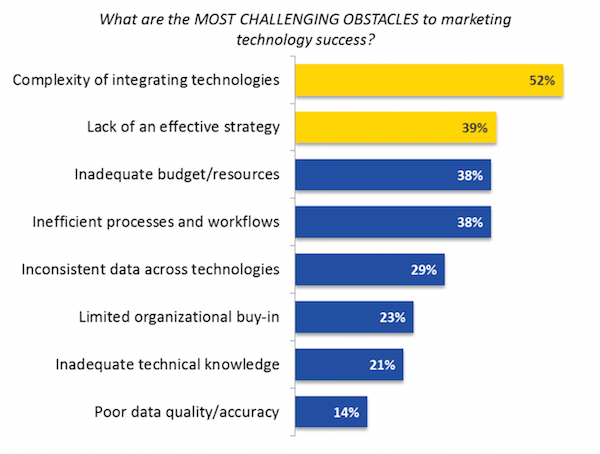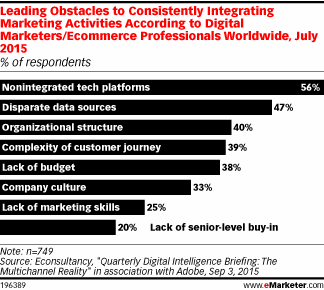
Is the “integration” challenge of marketing technology really our top obstacle?
There are two studies that I’ve come across in the past couple of weeks that have caused me to wonder if integration has become a bit of a red herring for marketers who are wrestling with the much more hairy, vicious, pointy-toothed beast of digital transformation.
The chart at the top of this page is from a brand new report by Ascend2, Informatica, and Dun & Bradstreet on B2B Marketing Technology Strategy listing the most challenging obstacles to marketing technology success. At the top of the list: 52% report complexity of integrating technologies.

This smaller chart from eMarketer, based on data from Econsultancy’s Quarterly Digital Intelligence Briefing: The Multichannel Reality lists leading obstacles to consistently integrating marketing activities. Again, top of the list: 56% report nonintegrated tech platforms.
It’s not surprising to me that integration is considered a challenge in these two studies.
What is surprising to me is that it was at the top of the list, by far, when compared with these other challenges:
- Lack of an effective strategy
- Inadequate budget/resources
- Inefficient processes and workflows
- Limited organizational buy-in
- Complexity of customer journey
- Organizational structure
- Company culture
Compared to those challenges, technical integration seems downright easy in comparison. I don’t want to trivialize the technical work involved. But I’ve been engaged in a lot of marketing technology integrations over the years, and it’s mostly black-and-white. You determine what data is available, and what data is desired, from one component to another. You configure the data exchange between them, or in less pre-defined integrations, figure out the APIs available for getting stuff in and out. You map the data flow, implement, test, and deploy.
That can be work, for sure, but when you’ve got someone technical involved — enter stage left the much-beloved character of a marketing technologist — it’s not mysterious.
And the truth is that marketing technology vendors have been making incredible progress on simplifying a lot of these integrations. Almost all of the major “marketing cloud” platforms have significantly improved their API layers and grown their ISV ecosystems of plugish-playish third-party products. Many of the specialist point solution products out there have invested in out-of-the-box integrations with those clouds, as well as peer-to-peer integrations with other products that they have the best synergies with. And the current generation of “marketing middleware” solutions — from tag management to cloud connectors — offer additional options for connecting the dots together.
Again, I’m not saying that integration isn’t a challenge, or that we don’t have further to go to improve that aspect of marketing technology. But ranking it as the primary obstacle to success seems a little exaggerated.
I just read a great article last week on TechCrunch by Randy Rayess, Is The CIO The Next VP Of Electricity? that seems to put integration challenges more in its proper place, so much so, that it threatens the future of the classic IT department: “Of course, implementing large SaaS tools like Salesforce or Workday usually requires some integration work, but the trend over the last few years clearly points to a decrease in integration requirements and the simplification of enterprise apps.”
Integration is getting easier. Marketing, however, is not.
Compare for a moment the challenge of “complexity of customer journey.” Only 39% said that was a leading challenge in that Econsultancy study. But that seems a much harder nut to crack, with customer touchpoints multiplying in a kaleidoscopic fashion around us.
To anyone who says, “Ah, but if only all our technology were all perfectly integrated, we could figure that out” — with all due respect, I call: “Bull-oney.”
If you have 100% of my digital exhaust — full access to everything I do online, on your site, or any other site — which clearly you don’t and won’t — you still wouldn’t be able to know my context or intent with rock-solid certainty. You don’t know what’s in my head. You don’t know the conversations I’m having with my colleagues. You don’t know my collective life history that influences how I think about the world. And the rate at which external factors are changing and influencing my thinking and priorities are beyond your reach.
A machine learning algorithm is not going to figure that out for you and automatically target me with the right auto-generated marketing to make me instantly decide, “I’ll buy!” More likely, you will overstep in your assumptions about me and simply turn me off of your brand.
Quoting Shakespeare: “There is more in heaven and earth than is computed in your algorithm.”
Sorry, there is no Magic Marketing Machine. (See Laplace’s demon for scientific limit.)
Now, all the data that you have access to gives you much more information about my context and intent than ever before. But it’s only pieces of a puzzle that still require human judgment and insight to relate to the right kind of content and services.
You, as a marketer, still need to understand my journey and develop the right content and services to best assist me in that journey. A journey that prospects control the pacing and flow of, not you. A journey that can have many more specialized steps — depending on who the prospect is and what their particular needs are — that you can potentially address, if you recognize it, relate to it, and create the right marketing for that moment.
Make no mistake, that is a ridiculously hard problem to solve. I don’t believe it’s possible to ever solve it perfectly. At best, you asymptotically approach an ideal. The design and UX aspects alone of that mission are epic.
It is certainly a waaaaaaay harder problem than integration.
And that’s just one of the other challenges mentioned in these two studies. Company culture? Not an easy thing to change. Effective strategy? Not an easy thing to develop. Organizational structure? Not an easy thing to reconfigure.
Those things are not black-and-white. There is no culture API. There is no data source for strategy. There is no plug-and-play digital organization add-on. These things are gray and fuzzy.
But they’re also where the real treasure is buried.
Any company can solve marketing technology integration. It might take some technical elbow grease, but it’s solvable. As result though, it’s not — at least not by itself — really a defensible competitive advantage. Any of your competitors can solve marketing technology integration too, should they choose to prioritize that.
Strategy. Culture. The organizational capital of modern marketing skills. Real insight into your customers’ journeys. New processes and workflows that leverage these capabilities — that’s the stuff of competitive advantage. Damn difficult, but super valuable.
And I’ll bet that marketing technology integration isn’t the gating factor to addressing most of those challenges in most companies. If you’re waiting on marketing tech nirvana, you’re almost certainly ceding your market opportunity to someone else.
Integration may be the most obvious obstacle, but it’s not the most challenging, and it’s not the most important.
Speaking of which…
It’s these other challenges surrounding marketing technology that the MarTech conference series aims to address head on.
Sure, we have some sessions around integration topics — that is a part of the marketing technology picture. But we have many more presentations focused on strategy, process, workflow, organizational structure, culture, management, the customer’s journey, and how marketing technology enables and supports the digital transformation of these elements of your business.
Our MarTech Europe conference is just a week and a half away. We’ve got a terrific line-up of speakers who will be covering the full gamut of marketing technology challenges and opportunities. If you’re interested in more than just the plumbing of marketing tech, I think you’ll really enjoy this two-day event.



